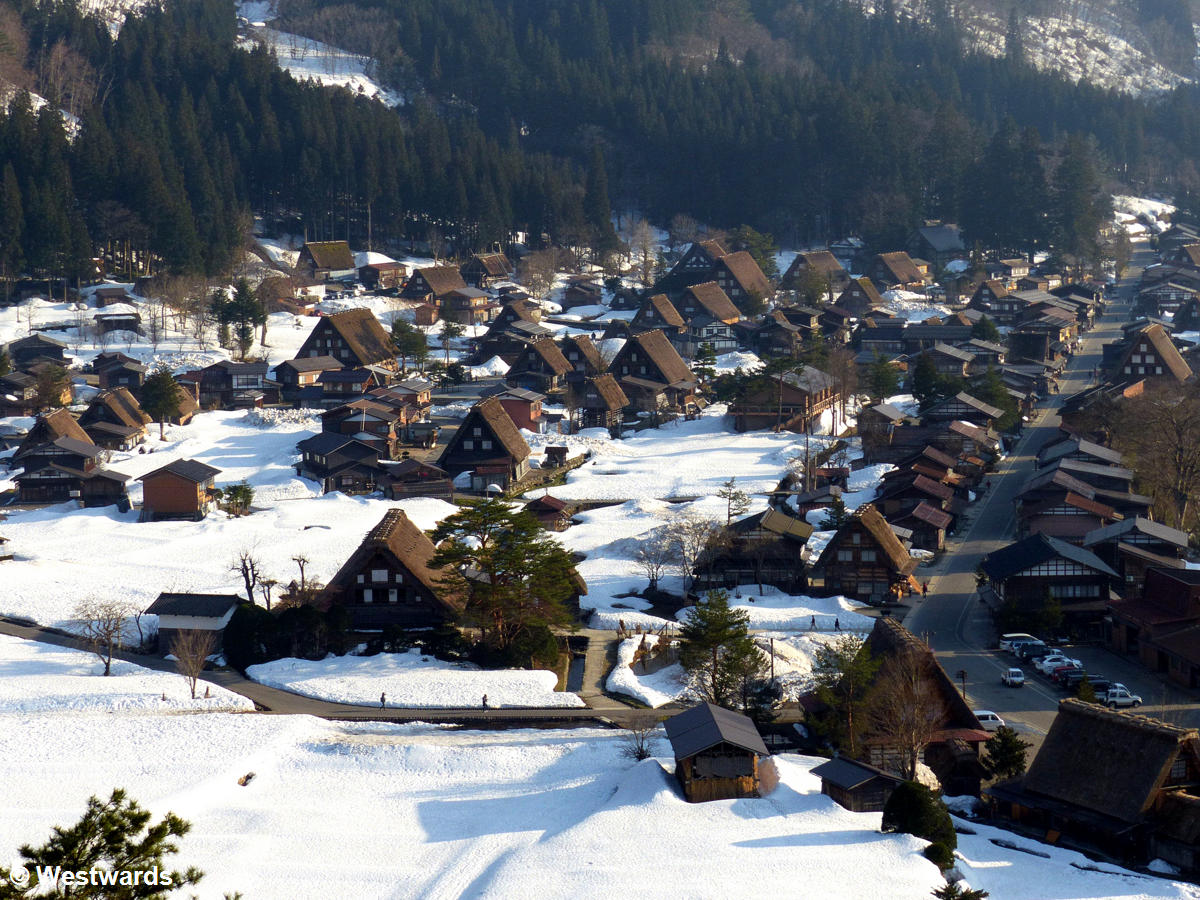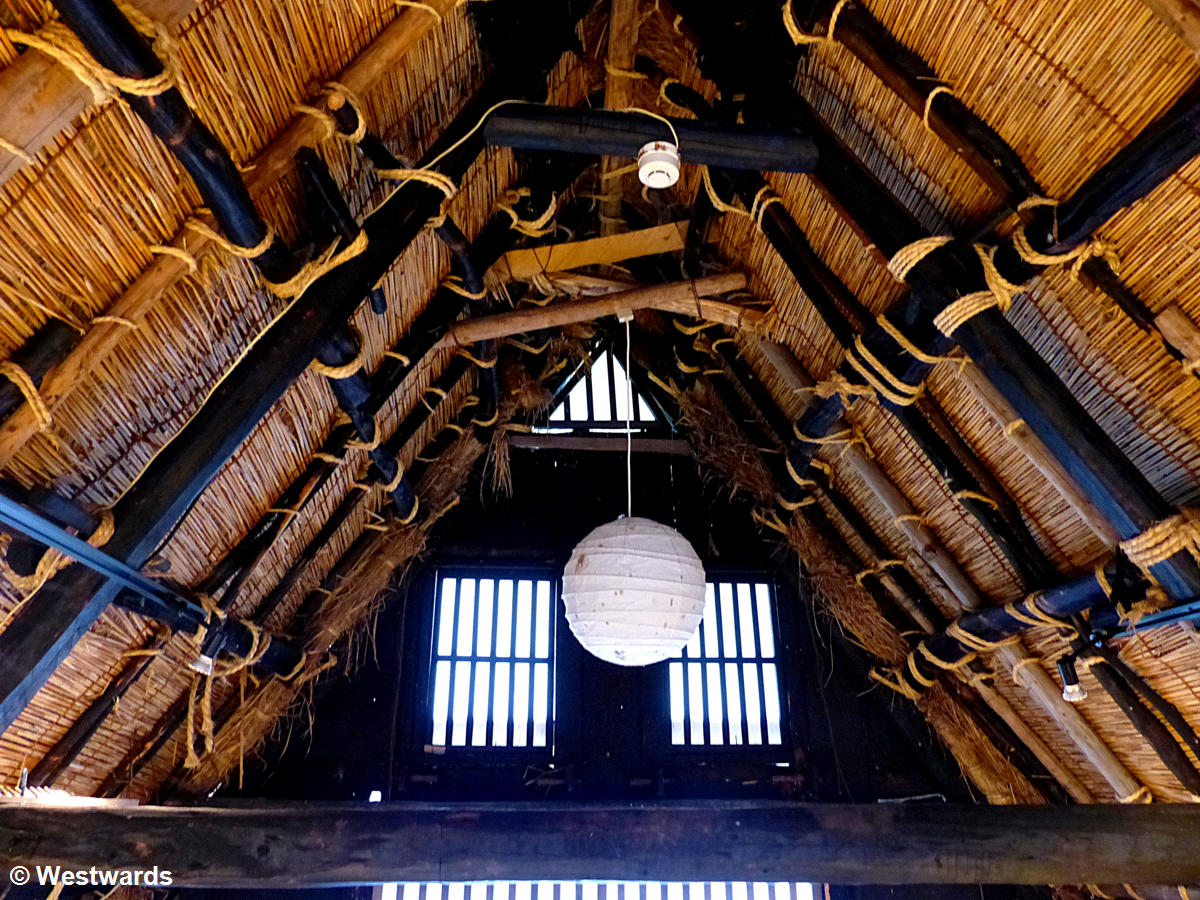
In the traditional villages of Shirakawa-go and Gokayama, the remoteness of the past is still tangible. Both Gokayama Village and Shirakawa-go Village have been listed as World Heritage sites in 1995. Not surprisingly, since then the number of visitors has been constantly growing. Even a boy from Takayama, now 73 and living in Tokyo, has finally made it to his childhood dream destination. The old man wearing thick glasses and a beige cloth hat explains to us:
„When I was a boy, my older cousins used to go to Shirakawa-go once or twice a year. It was shortly after the war and I had been sent to live in Takayama with relatives as our family house in Osaka was bombed. The older boys wouldn’t take me because I was a child, and they said the journey over the three mountain passes would be too arduous for my short legs.”

Roofs like hands folded in prayer
Before the modern road was built, the villages of Shirakawa-go and Gokayama could only be reached on foot. In winter icy Siberian winds bring meters of snow and frosty temperatures. Of old, the inhabitants of these villages in Japan’s mountainous interior have adapted their houses to such harsh conditions. Doors on the first floor leading outside can be used in severe winters when the ground floor is snowed up. Steep roofs pointing towards heaven let the thick snow cover slide down to the ground. Their name, Gasshô roof, recalls the folded hands of prayer.


“The roofs are built only with reed and wooden beams, without using a single nail,” Nagase-san explains, showing us around in her family’s 250 year old house. In former times the whole village helped to renew the enormous reed cover of the roofs in turns. But today only about 20 families still have houses with the traditional roofs, not enough to keep the old system alive. “So we issued a call for volunteers and about 500 people from all over Japan offered their help. We could only accept the ones who had at least some experience, because otherwise the work on the high roofs is too dangerous.” We have reached the attic by now, and Nagase-san shows us one of the ropes that hold the beams in place. It has already become loose. The volunteers from warmer parts of Japan were apparently not so familiar with the prayer-style roofs.

Silk production in Shirakawa-go Village
Until WWII the villagers of Shirakawa-go and Gokayama used to grow silkworms on the upper floors to produce silk. Like everyone in the villages telling us about the silkworms, Nagase-san calls them “o-kaiko-san”: the honourable silkworms. They have disappeared now together with their favourite food, mulberry leaves, because during the war everyone had to cut off the mulberry trees in order to plant rice.
The honourable silkworms also brought a supplementary income to the inhabitants of the village of Suganuma, a part of Gokayama. Unlike the not very distant Shirakawa-go, the village belonged to the old Kaga prefecture. Kaga’s rulers, the Maeda clan, were keen to hold their own against the central government in Edo and did their best to keep a strong independent army. Originally, it was the Maeda clan who instructed the villagers to raise silkworms: their faeces were an important ingredient in the production of gunpowder. Thus, the locals could pay their taxes in gunpowder rather than the customary but scarce rice. Although this was an open secret to the Tokugawa Shoguns in Edo – today’s Tokyo – they were unable to intervene due to the isolation of the area.
The famous sake festival
“Actually, I think now that my cousins took the strenuous hike over the mountains in order to drink alcohol”
The old man muses.


“After all, these villages were after the war one of the few places that were allowed to brew sake for a traditional festival. That must have been the real reason why they would not take me!” And even today tourists and locals enjoy the traditional festival with free sake for all.
As always, it was great to spend time in a village such as Shirakawa-go with locals. Even with a group of foreign tourists, we could experience something of the local village spirit. This is often easier during small local festivals – we even found that in Germany when we happened to be in Kochel during a local religious fair: it was very exotic! Otherwise, we have sometimes – like in Jordan – gone rather off the beaten track into small towns to meet with and talk to average people.
NB: We had no sponsoring for this blog post about travel to Shirakawa-go and Gokayama villages. We travel regularly to both of them, sometimes as guides for German tour groups. Or else, for updates of our various travel guidebooks about Japan, for instance: Stefan Loose Japan, Trescher Japan. (For qualified purchases of books we link to from this blog, we may earn a commission, at no extra cost to you).
Never miss a new post! Get notifications about new posts straight into your inbox!
Take this pin:




Wow! I must visit that place, especially the prayer roofs. They look like bigger versions of teepees. I’m just amazed on how the roofs were built without using nails. It’s just awesome.